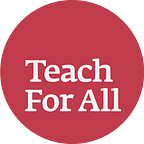Putting Students at the Center
By Pratibha Naranyan, Teach For India alumna and Program Head at Involve Learning Solutions Foundation
Throughout the past two years we’ve seen firsthand the unprecedented upheaval in education systems around the world. Educators and policy makers everywhere are debating what we should focus on now to ensure that this disruption does not create a lifelong burden for this generation. We put out a call to our network to seek insights from educators on this question. This essay was submitted in response to the question “What do students need now?”
“I haven’t been to school in almost two years now.”
“I miss meeting my friends and teachers.”
“I was not able to learn through online classes because my parents didn’t have a smartphone.”
This is what the past two years have looked like for our students in India. With schools being closed for almost two academic years now, students have been feeling lost. The social, emotional, and mental cost of the pandemic has been equal to, if not greater than, the learning loss that it has created.
As we limp back to normalcy and learn to live with the restrictions imposed by the pandemic, the question “What do students need now?” needs to be answered. Over the past two years, our organization has worked with more than 2000 students. Through interactions with students, teachers, and school leaders we identified that, in the process of recovering from impact of the pandemic, students need;
a. Safe learning spaces where they can remedy the lost learning
b. Spaces to re-establish social connections within their peers and with the school community
c. Opportunities to debrief and reflect on the experiences they have had over the past two years
To accomplish this, I believe there is an urgent and important need to put student needs at the center of decision making towards rebuilding the education system. The past two years have shown us that when faced with adversity, what keeps people moving is their resilience and the level of agency they have in their lives. Similarly, for our students, the pandemic has highlighted the need to develop their resilience and build in them a sense of agency and ownership of their learning and growth.
This need opens up a large opportunity for educators to shift the current model of education to one that is more student-centric. One way to bring about this shift is the use of peer-based pedagogies to both remediate learning gaps and address the socio-emotional needs of the students. Our organization Involve Learning Solutions Foundation (www.involveedu.com) has been working in this space for the past three years, and now more than ever we see how peer learning and teaching can be the next pedagogical revolution for the education system.
Over the past three years we have piloted online and offline models of peer mentoring, peer teaching, and peer learning. A peer teaching model, in which senior students teach their juniors, can be used to promote personalized teaching and learning at the right level, allowing students to bridge their learning gaps at their own pace. The defining feature of peer teaching is the group structure, which is created based on standardized assessments of learning level as opposed to grades or age. With focus on foundational skills instead of curriculum, the peer teaching model is the first student led model of teaching and learning. It also enables students to have a safe peer space to share their experiences and challenges, and celebrate their successes.
Through our programs we have seen the impact of peer teaching on learning outcomes and the leadership and socio-emotional skills of our students.
- Learners in our program have shown an average of 37% improvement on numeracy scores, and a 2 level improvement on reading fluency.
- The senior students have shown improved confidence and stronger communication and problem solving skills as a result of their experience of teaching their juniors.
- Over 80% of students who have participated in our programs have stated that this method not only enhanced their learning but also provided them a chance to form social connections with their peers.
Most importantly, through the program, we have seen all students taking more ownership of their learning, with more students displaying positive attitudes to learning and improved attendance in the peer teaching classes over time.
The pandemic has highlighted the need to reinvent pedagogies, and particularly the ownership of learning. This applies to both formal learning spaces like schools, but also to informal community-based learning spaces. The next two to three years will be crucial in determining the direction our education system will take. We must leverage the strengths of our students and provide them the support they need to be the driving forces and decision makers within the system.
